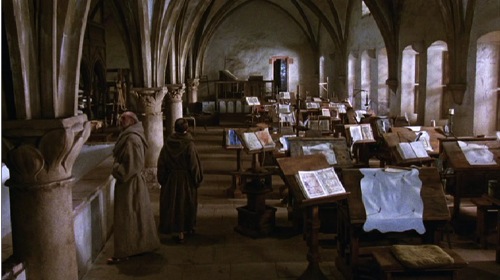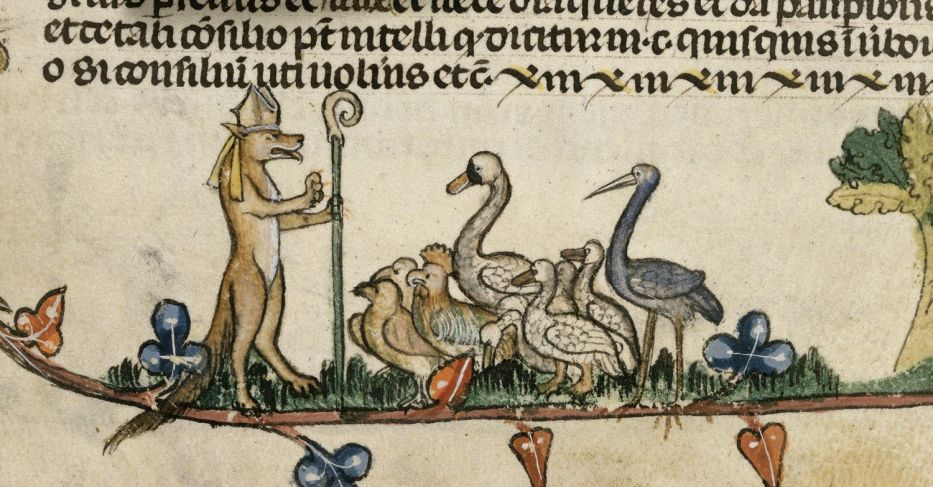Is weeping more Christ-like than laughing? Dr Lucy Allen is a medievalist working on the literature and culture of late-medieval England, and as a teaching associate of the English Faculty at the University of Cambridge. In this post, re-published with kind permission from Lucy’s ‘Jeanne de Montbaston’ blog, she explores the histories of tears and laughter, through the writings of John Donne and Umberto Eco.

East Window, King’s College Cambridge
At 5.30pm on Monday this week (22 February 2016), I was sitting in King’s College Chapel, looking up at the stained glass, which – from where I was – was mostly shades of blue, with the afternoon light behind it. We were waiting for the beginning of a service, a service for Lent, on the theme of tears. As we waited, candles were lit, and by the time the choir began to sing, the fading light outside made the stained glass darken almost to black.
I was noticing these details, because I’d got there early. I was running over the passages from a sermon by John Donne, which I was going to read. Donne’s sermon is based on the text from John’s Gospel, in which Jesus responds to the death of Lazarus by weeping. All week, I’d been enjoying getting emails from the chaplain of King’s with the faintly blasphemous-sounding subject line Jesus Wept. But Donne takes a predictably serious approach, and he makes a characteristically perceptive point that, while the Bible describes God in terms of human body parts (hands and feet, eyes and ears) as well as human emotions:
I do not remember that ever God is said to have wept. It is for man. And when God shall come to that last act in the glorifying of man, when he promises ‘to wipe all tears from his eyes’, what shall God have to do with that eye that never wept?
I enjoyed this point, and this rhetoric, but while I was enjoying it, I was also figuring out how to negotiate one of those lines you can’t read without raising an irritated feminist eyebrow. Discussing the idea of Jesus weeping, Donne comments on contemporary attitudes towards tears:
We call it a childish thing to weep, and a womanish; and perchance we mean worse in that than in the childish; for therein we mean falsehood to be mingled with weakness.
Donne glides over the idea of duplicitous feminine tears so quickly you don’t have time to explore the implications of the claim, nor what it says about the visibility of emotion and the sincerity of feeling. Donne would not be the only writer to see tears as something that should be contained, repressed, controlled, kept within the limits of the body. But Dr Thomas Dixon – who’s a historian at Queen Mary – gave the fascinating and wide-ranging address during this service, and he pointed out that Donne was writing at a time of rapidly-shifting ideas about the acceptability of emotion, a time of post-Reformation perceptions of medieval emotional display as a form of excess or insincerity. Dixon also notes that Donne is one of a very few sermon writers to discuss Christ’s tears, and I admit that this surprised me.
I was thinking back to the conversation about another kind of emotion Christ may – or may not – have displayed, which is notoriously central to the plot of Umberto Eco’s Name of the Rose. Eco died this week, and I was reading obituaries and reviews of his books.
The Name of the Rose is a classic detective story, transplanted to the early fourteenth century, and told from the perspective of a wet-behind-the-ears young monk, Adso, and his preternaturally observant, cynical, and jaded mentor, the evocatively-named William of Baskerville. Both men are visitors to a monastery in which mysterious and gruesome events are occurring, in best murder mystery tradition. But if William of Baskerville is a composite of Sherlock Holmes and of the stagey trickery that created one of his most famous cases, he’s also a skilled theologian, and early on in the novel he and Adso become dragged into what seems to be an absurdly dry argument over whether or not Christ ever laughed.

William and Adso in the Library. Still from The Name of the Rose (1986)
Looking over the comical and carnivalesque illuminations in a manuscript in the scriptorium, William is amused by scenes of abbot-monkeys and pope-foxes. Jorge of Burgos, an impeccably pious, irascible and deeply misogynistic scholar, declares that it is blasphemous to imagine that Christ – in full knowledge of human sin and sorrow – could ever have engaged in something as carnal and trivial as laughter. Amongst the thorns in his side is the charismatic dilettante and – whisper it – possibly not entirely heterosexual Berengar, the assistant librarian, who, it turns out, has been attempting to probe the hidden secrets of the monastery library. When William refers learnedly to Aristotle’s famous, lost treatise on Comedy, Jorge responds with rage, insisting that such a book could never have been written.

The Pope as a fox. London, BL MS 10 E. IV, f. 49v (detail)
Their argument is, as you’ll see, based on real theological points of view. I’ll quote from the film script, since I enjoy imaging Sean Connery’s accent as William:
Jorge: Laughter is a devilish wind which deforms the lineaments of the face, and makes men look like monkeys.
William: Monkeys do not laugh. Laughter is particular to man.
And you can watch a fuller clip here:
https://www.youtube.com/watch?v=jUUB96c6EpY
You can see that the outline of the debate is the same one that Donne presses into service in his discussion of Christ’s tears. While William (and Eco) describe laughter as particular to man, as opposed to animals, Donne describes tears as particular to man, as opposed to God. Together, they form a theory of emotion that determines the ordained place of humankind in the scheme of things. But gender doesn’t seem to come into it – at least, until I came across this old review of The Name of the Rose, written in 1983. It’s spiky praise, given grudgingly:
Filled with the good-natured polyglot banter of the superfluously learned, “The Name of the Rose” might be seen only as a effete “Canterbury Tales” except for tell-tale markings on the walls of its medieval monastic library, markings declaring that this records of those walls’ destruction is itself a labyrinth in the library’s image.
It’s that word ‘effete’ that caught my attention. It’s a rarely-used term today: our vocabulary of habitual and ingrained misogyny is fashionably up to date. I have my suspicions about what the author might have considered ‘effete’ – from Eco’s choosing a genre usually dominated by women, to the portrayals of monastic homosexuality, to his poncey in-joke academic pastiches of language – but, as I was thinking about emotion, its containment and its display, it made me reassess a crucial scene in the novel, and the understated way it plays with gendered expectations.
As William and Adso become dragged further and further into the disturbing events of the monastery, they find themselves investigating a series of gruesome murders that seem somehow to relate to the highly secret portions of the monastery’s impressive and labyrinthine library. Racing through that library with suspicions mounting in their minds, William and Adso discover the seemingly Stoical, dispassionate and authoritative Jorge, the monk who has spoken out so harshly against the idea of a laughing Christ, desperately cramming the poisoned pages of a book into his mouth in an act of destruction that will also kill him. It transpires that the fabled Aristotelian treatise on Comedy does indeed exist – hidden within the depths of the library – and that Jorge, having failed to suppress rumours of its existence, had daubed the pages in poison to trick any reader who licked his fingers as he leafed through the forbidden accounts of laughter.

William and Adso confront Jorge. Still from The Name of the Rose (1986)
This frenzied activity is, to a medieval eye, not simply bizarre and desperate. It’s also gendered. In medieval religious literature, there’s a huge and long-standing tradition of imagining readers who devour their books. But – crucially – they are women. Religious writers approvingly described how holy women, from St Cecilia to the Virgin Mary herself, devoured the words of the Bible as if chewing, eating, and enjoying the sweet taste of the book; instructional works directed to women described how a female reader should feel and imagine each word in her mouth as she shaped its syllables with her lips. The root of this image is a quintessentially feminine experience, that of pregnancy: as Mary read the words of the Bible, she became aware of the angel Gabriel, come to tell her that she was to bear the Word of God.
So, when Eco has an elderly male monk – a fanatic, opposed to laughter and display of emotion – cram the pages of a book into his mouth, he’s participating in this tradition of gendering the internalisation and the display of emotion. The eating of the book feminises Jorge, even as he attempts to destroy the evidence of Christ displaying an emotion that later writers would see as suspiciously human, even suspiciously feminine. But Eco also participates in a process of aligning the medieval – as represented by Jorge and his ilk, and challenged by the proto-Humanist and rational William – with the crazed repression of emotion, the distorted and dishonest response to religion, that post-Reformation writers would seize upon for polemical purposes, like Donne’s.
Read more at Lucy Allen’s ‘Jeanne de Montbaston’ blog
Follow Lucy on Twitter: @LucyAllenFWR

